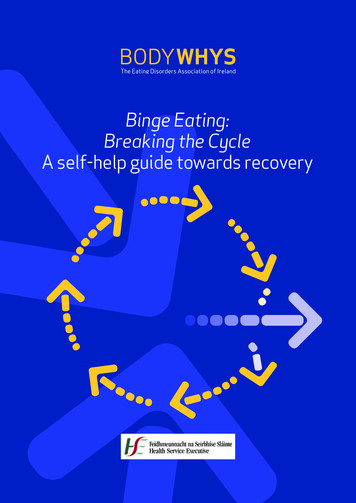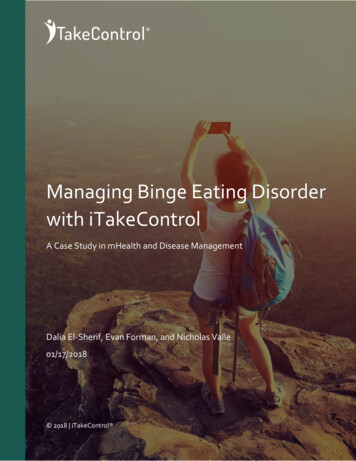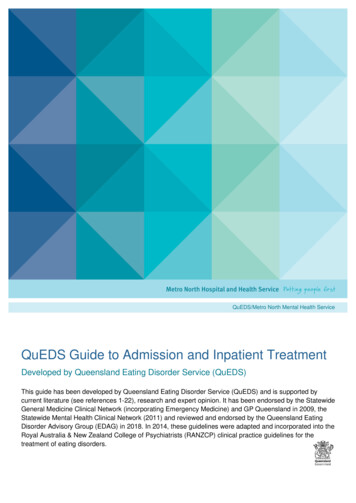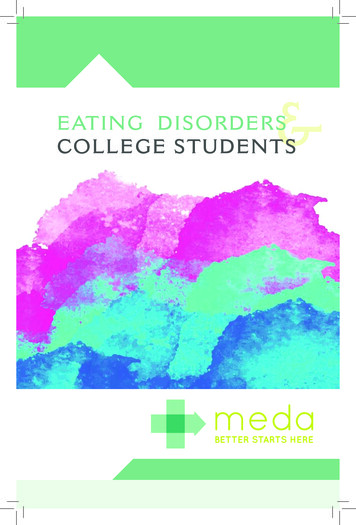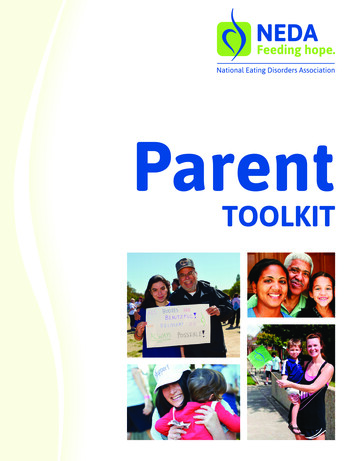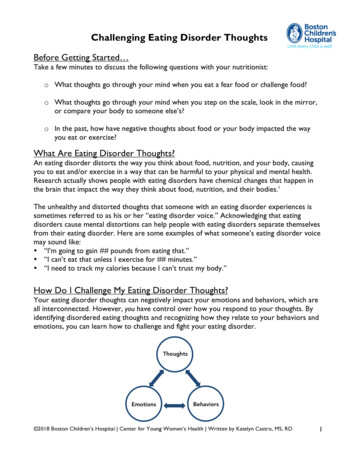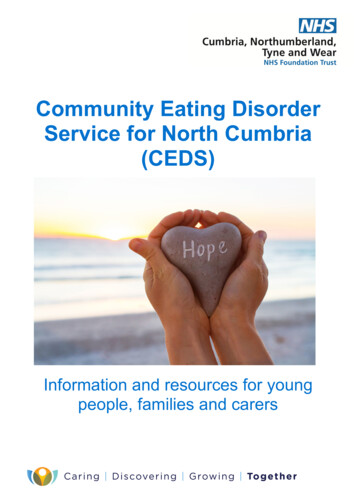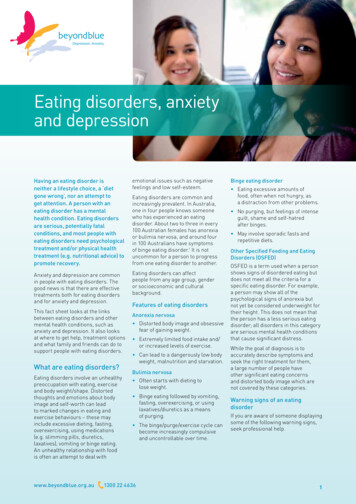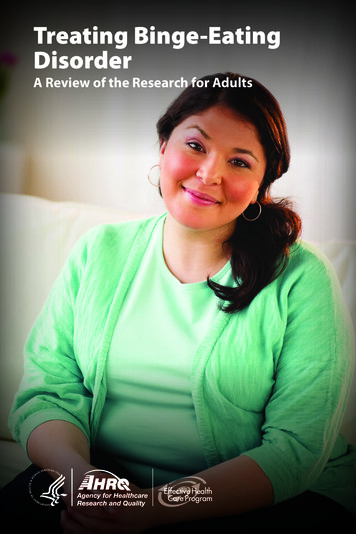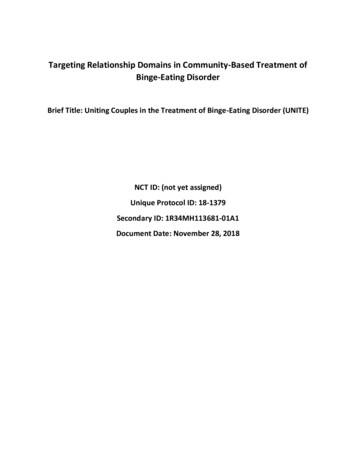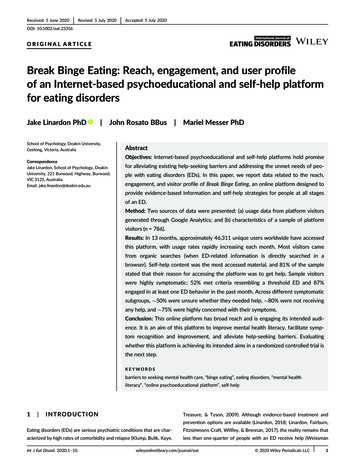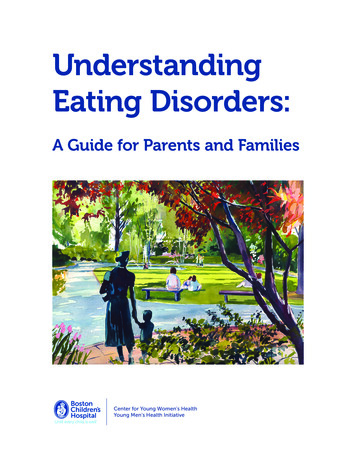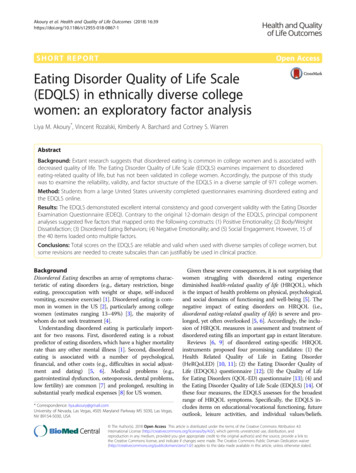
Transcription
Akoury et al. Health and Quality of Life Outcomes (2018) T REPORTOpen AccessEating Disorder Quality of Life Scale(EDQLS) in ethnically diverse collegewomen: an exploratory factor analysisLiya M. Akoury*, Vincent Rozalski, Kimberly A. Barchard and Cortney S. WarrenAbstractBackground: Extant research suggests that disordered eating is common in college women and is associated withdecreased quality of life. The Eating Disorder Quality of Life Scale (EDQLS) examines impairment to disorderedeating-related quality of life, but has not been validated in college women. Accordingly, the purpose of this studywas to examine the reliability, validity, and factor structure of the EDQLS in a diverse sample of 971 college women.Method: Students from a large United States university completed questionnaires examining disordered eating andthe EDQLS online.Results: The EDQLS demonstrated excellent internal consistency and good convergent validity with the Eating DisorderExamination Questionnaire (EDEQ). Contrary to the original 12-domain design of the EDQLS, principal componentanalyses suggested five factors that mapped onto the following constructs: (1) Positive Emotionality; (2) Body/WeightDissatisfaction; (3) Disordered Eating Behaviors; (4) Negative Emotionality; and (5) Social Engagement. However, 15 ofthe 40 items loaded onto multiple factors.Conclusions: Total scores on the EDQLS are reliable and valid when used with diverse samples of college women, butsome revisions are needed to create subscales than can justifiably be used in clinical practice.BackgroundDisordered Eating describes an array of symptoms characteristic of eating disorders (e.g., dietary restriction, bingeeating, preoccupation with weight or shape, self-inducedvomiting, excessive exercise) [1]. Disordered eating is common in women in the US [2], particularly among collegewomen (estimates ranging 13–49%) [3], the majority ofwhom do not seek treatment [4].Understanding disordered eating is particularly important for two reasons. First, disordered eating is a robustpredictor of eating disorders, which have a higher mortalityrate than any other mental illness [1]. Second, disorderedeating is associated with a number of psychological,financial, and other costs (e.g., difficulties in social adjustment and dating) [5, 6]. Medical problems (e.g.,gastrointestinal dysfunction, osteoporosis, dental problems,low fertility) are common [7] and prolonged, resulting insubstantial yearly medical expenses [8] for US women.* Correspondence: liya.akoury@gmail.comUniversity of Nevada, Las Vegas, 4505 Maryland Parkway MS 5030, Las Vegas,NV 89154-5030, USAGiven these severe consequences, it is not surprising thatwomen struggling with disordered eating experiencediminished health-related quality of life (HRQOL), whichis the impact of health problems on physical, psychological,and social domains of functioning and well-being [5]. Thenegative impact of eating disorders on HRQOL (i.e.,disordered eating-related quality of life) is severe and prolonged, yet often overlooked [5, 6]. Accordingly, the inclusion of HRQOL measures in assessment and treatment ofdisordered eating fills an important gap in extant literature.Reviews [6, 9] of disordered eating-specific HRQOLinstruments proposed four promising candidates: (1) theHealth Related Quality of Life in Eating Disorder(HeRQoLED) [10, 11]; (2) the Eating Disorder Quality ofLife (EDQOL) questionnaire [12]; (3) the Quality of Lifefor Eating Disorders (QOL-ED) questionnaire [13]; (4) andthe Eating Disorder Quality of Life Scale (EDQLS) [14]. Ofthese four measures, the EDQLS assesses for the broadestrange of HRQOL symptoms. Specifically, the EDQLS includes items on educational/vocational functioning, futureoutlook, leisure activities, and individual values/beliefs. The Author(s). 2018 Open Access This article is distributed under the terms of the Creative Commons Attribution 4.0International License (http://creativecommons.org/licenses/by/4.0/), which permits unrestricted use, distribution, andreproduction in any medium, provided you give appropriate credit to the original author(s) and the source, provide a link tothe Creative Commons license, and indicate if changes were made. The Creative Commons Public Domain Dedication o/1.0/) applies to the data made available in this article, unless otherwise stated.
Akoury et al. Health and Quality of Life Outcomes (2018) 16:39These additional domains may be developmentally salientfor adolescents and emerging adults, including collegewomen. As such, it may be a be a more robust measure forHRQOL for populations who are the highest risk for disordered eating [1]. Unfortunately, to date, the EDQLS hassolely been validated in clinical samples [14, 15]. Therefore,validation of the EDQLS in non-clinical samples is acritical next step. Accordingly, the purpose of this studywas to examine the psychometric properties for theEDQLS in a large, diverse sample of US college women.MethodAimsThe aim of this study was to test the factor structure,reliability, and validity of the EDQLS when correlatedwith the Eating Disorder Examination Questionnaire[16], in a sample of ethnically diverse college women.ParticipantsParticipants were 971 college women at a large university in the Southwestern US, recruited through thepsychology subject pool for an online study on bodyimage and ethnic identity [17]. Ages ranged from 18 to66 years (M 19.97; SD 3.90), and body mass index(BMI) ranged from 12.93 to 51.68 kg/m2 (M 23.43: SD 4.88). Participants were 28.4% European American,12.0% African American, 21.8% Asian American, 28.0%Latina American, 0.70% Native American, 8.4% multiracial or of a different race, 0.5% of unreported race(s).MeasuresDisordered eating-related QOLEDQLS [14] is a 40-item questionnaire designed to measure 12 domains of disordered eating-related QOL: (1) Cognitive; (2) Educational/Vocational; (3) Family and CloseRelationships; (4) Relationships with Others; (5) FutureOutlook; (6) Appearance; (7) Leisure; (8) Psychological; (9)Emotional; (10) Values and Beliefs; (11) Physical; (12)Eating. Items are rated on a 5-point scale, ranging from (1)Strongly Disagree to (5) Strongly Agree. Higher scores indicate higher QOL; 22 items are reverse-coded. EDQLSshowed high internal consistency (Cronbach’s alpha: .96)[14]. Because we administered the EDQLS to a nonclinical sample, we replaced the words eating disorder witheating habits for the three relevant items, with the authors’permission. In the current sample, scores ranged from 76to 193, with a mean score of 145 (SD 21.45), indicatinghigher QOL compared to the original clinical sample [14].Disordered eatingThe EDE-Q is a 31-item self-report questionnaire withfour subscales: (1) Dietary Restraint (i.e., dieting, limitingor avoiding food); (2) Eating Concerns (i.e., preoccupationwith food, secretiveness, and guilt about eating); (3) ShapePage 2 of 5Concerns (i.e., preoccupation with shape, body, or a flatstomach); and (4) Weight Concerns (i.e., preoccupationwith weight and weight loss). Items are rated over the past28 days on a 7-point scale (e.g., “No days” to “Every day”or “Not at all” to “Markedly”), with higher scores indicating higher levels of disordered eating symptoms [16]. TheEDE-Q demonstrated excellent internal consistency in thissample (Cronbach’s alpha .94).Statistical analysesWe used SPSS Version 20 for all statistical analyses.Preliminary analyses of the EDQLS were as follows: (1) internal consistency, using Cronbach’s alphas; (2) correcteditem-total correlation and alpha-if-item-deleted statisticsto determine whether any items reduced internalconsistency; (3) convergent validity with the EDE-Q, usingPearson’s correlations of each EDQLS item and totalEDQLS score with the overall EDE-Q score; and (4) firstprincipal component to determine whether all items arerelated to the same general construct.To determine EDQLS factor structure, we conducted aprincipal components analysis with multiple factors. Weused four criteria to determine the number of factors: (1)previous validation of the EDQLS [14] (suggesting up toeight factors); (2) Scree plot (suggesting five factors); (3)parallel analysis [18, 19] (suggesting five factors); and (4)the minimum average partial test [20] (suggesting fourfactors). Because the scree plot and parallel analysisagreed, we proceeded with a 5-factor solution. Afterexamining several different rotations, we selected the direct oblimin rotation with delta set to 1, because it hadthe smallest number of complex items, small correlationsbetween the factors, and a high number of hyperplanarloadings. Factor loadings were considered salient if theywere .30 or higher.ResultsInternal consistency and validityTable 1 summarizes internal consistency and convergentvalidity results. Cronbach’s alpha (.93; 95% CI [.91, .93])indicated excellent internal consistency reliability (Table 1).All items had similar values of alpha-if-item-deleted, butitems 24 and 32 had poor corrected item-totalcorrelations.The EDQLS had a large negative correlation with theEDEQ (r(969) .63, p .001), demonstrating the convergent validity of the EDQLS: Disordered eating-relatedQOL is worse among those with more severe disorderedeating symptoms. Items 3 and 24 had non-significant andnear-zero correlations with the total score of the EDEQ,suggesting poor convergent validity for these two items.For the first principal component, all matrix coefficientsmatched in valence (i.e., all positively keyed items hadpositive loadings; all negatively keyed items have negative
Akoury et al. Health and Quality of Life Outcomes (2018) 16:39Table 1 Item analysis to improve internal ach’salpha if itemdeletedCorrelationwith EDEQtotal scoreLoading on1st principalcomponent1.39.92 .07* .442.40.92 .21**.513.26.92 .03 .334.27.92 .175.24.92 .32** .45.53**.416.41.92 .297.29.92 .16** .46.33**8.29.92 .389.32.92 .22** .44** .48**10.45.92 .0911.35.92 .17** .47.2212.25.92 .2013.53.92 .39** .63 .52**14.37.92 .2415.42.92 .51**.57**.53**16.37.92 .3517.51.92 .39**.70**.5318.45.92 .6219.26.92 .24**.43** .3120.26.92 .1121.51.92 .21** .56**.5622.44.92 .2123.42.92 .45**.5724.14.92 .01 .2125.51.92 .65**.52** .6326.57.92 .2827.46.92 .15** .45 .5128.39.92 .1829.50.92 .37**.50**.72**30.61.92 .4731.56.92 .63**.63 .2732.17.92 .0833.26.92 .36** .47**.45*34.43.92 .3635.53.92 .42**.60 .5136.36.92 .1837.59.92 .39**.71**.61**38.58.92 .6839.58.92 .51**.61.92 .24.4840.45**Coefficient alpha for the 40-item test is .93. Coefficient alpha for the first principal component is .94. Item stems are not shown, per copyright restrictions*p .05, ** p .01Page 3 of 5loadings). Items 12, 24, and 32 had non-salient loadings(absolute values less than .30).Exploratory factor analysisPrincipal components analysis suggested a 5-factor structure, accounting for 46.78% of EDQLS variance (25.98% byFactor 1; 8.72% by Factor 2; 4.86% by Factor 3; 3.66% byFactor 4; and 3.58% by Factor 5). When EDQLS items weregrouped into five scales, based on the 5-factor structure,Cronbach’s alphas were adequate to good (.81 for Factor 1;.82 for Factor 2; .76 for Factor 3; .72 for Factor 4; and .76for Factor 5). Tables 2 shows the rotated factor patternmatrix and our factor interpretations (items stems are notshown, per copyright restrictions).Factor 1, Positive Emotionality, assessed hopefulnessabout the future, self-esteem and fulfilling relationships.Factor 2, Body/Weight Dissatisfaction, assessed bodyimage and strict dieting. Factor 3, Disordered EatingBehaviors, assessed preoccupation with food and subsequent family conflict. Factor 4, Negative Emotionality,assessed anxiety, self-doubt and other negative cognitions. Factor 5, Social Engagement, assessed positivemood and social interactions.Interpretation of the 5-factor structure was somewhatcomplicated by the 15 items that cross-loaded betweentwo factors. Interestingly, Factor 2 (Body/Weight Dissatisfaction) contained the most cross-loading items: Bodyimage-related items (e.g., item 25) did not cross-load,while behavioral items (e.g., item 15) did.DiscussionThis study examined the psychometric properties of theEating Disorder Quality of Life Scale (EDQLS) in a large,diverse sample of college women. Results indicated excellent internal consistency and convergent validity with theEDEQ and support the use of total scores on the EDQLSin college women. Given that disordered eating is commonamong college women [4], evidence for the reliability andvalidity of the EDQLS in this population thus paves theway for additional research on HRQOL.Our data suggested five factors: (1) Positive Emotionality;(2) Body/Weight Dissatisfaction; (3) Disordered EatingBehaviors; (4) Negative Emotionality; and (5) SocialEngagement. As such, for college women, disorderedeating-related QOL appears dependent on symptomatology, but also on valence of emotionality and on quality ofsocial support. Additionally, negative emotionality likelycontributes to both disordered eating-related QOL and toQOL in general, as individuals high on neuroticism aremore prone to experience negative emotions and tend toexhibit more severe disordered eating symptoms [21].However, these five factors do not match the previouslyproposed 12 domains [14, 15]; nor did the 12 domainscombine to create five factors (i.e., items within domains
Akoury et al. Health and Quality of Life Outcomes (2018) 16:39Page 4 of 5Table 2 Factor Pattern Matrix Results for Rotated FactorsItem26Factorh12345.70.20.07.02.022Table 2 Factor Pattern Matrix Results for Rotated .01.52Factor Intercorrelations21.60.11.25.19.06.55Factor 11.0013.60.34.03.01.09.58Factor 2.141.00-.11-.251.00436.58.05.06.06.10.44Factor 314.49.13.10.16.13.41Factor 4.21.27-.121.00.41Factor 0.15.42.43.489.33.13.14.02.34.3451.002Note. h communality. Salient factor pattern matrix coefficients are inboldface. No items were reverse-scored for this analysis. Factor 1 PositiveEmotionality; Factor 2 Body/Weight Dissatisfaction; Factor 3 DisorderedEating Behaviors; Factor 4 Negative Emotionality; Factor 5 LifeEngagementloaded on different factors). Moreover, over one-third ofthe items loaded on multiple factors, demonstrating thateven these factors are not distinct. Thus, our results donot support the use and interpretation of domain or subscale scores. However, domain or subscale scores will beessential to understanding the implications of disorderedeating in clinical and community populations. We therefore urge additional research on the domains and factorsof disordered eating-related quality of life, particularlythrough EDQLS scale revision and confirmatory factoranalyses.Per recommendations for exploratory factor analyses[22], the large sample size is a major strength, likely toproduce a stable and replicable factor structure. Inaddition, participants were ethnically diverse collegewomen, from one of most diverse universities in the US.As such, results may be somewhat more representativeof the general US population than would be the casewith traditional college samples, and may pave way fordisordered eating-related QOL research in ethnically diverse populations. Accordingly, future studies shouldcompare the EDQLS factor structure and the reliabilityand validity of domain scores in this and other populations. On the other hand, one limitation of our researchwas that we rephrased three items to include eatinghabits, rather than eating disorder: Participants mayhave reflected on their dietary preferences (e.g.,veganism), rather than disordered eating symptoms.Future research should determine how the factor structure, reliability, and validity of the EDQLS are influencedby an explicit focus on disordered eating. Futureresearch should also explore whether other personalitycorrelates of disordered eating (e.g., perfectionism) [21]are important components of disordered eating-relatedQOL. Such research can inform future revisions of theEDQLS to create informative subscores to furtherimprove this promising scale.
Akoury et al. Health and Quality of Life Outcomes (2018) 16:39Page 5 of 5ConclusionOverall results support the use of the EDQLS total scoresin ethnically diverse college women. Contrary to theoriginal 12-domain design of the EDQLS, principal components analysis suggested that the EDQLS had five factorsthat mapped onto the following constructs: (1) PositiveEmotionality; (2) Body/Weight Dissatisfaction; (3)Disordered Eating Behaviors; (4) Negative Emotionality;and (5) Social Engagement. We therefore recommendrevision of the EDQLS so that subscale scores can be used.6.AbbreviationsBMI: Body mass index; EDE-Q: Eating Disorder Examination Questionnaire;EDQLS: Eating Disorder Quality of Life Scale; HeRQoLED: Health RelatedQuality of Life in Eating Disorder; HRQOL: Health-related quality of life;QOL: Quality of life9.4.5.7.8.10.AcknowledgementsWe thank all study participants for providing data for this study. We alsothank Drs. Adair and Marcoux for designing the EDQLS and for allowing usto purchase the rights for its use.FundingA student license for the EDQLS was purchased with the support of the localuniversity’s Graduate and Professional Student Association (UNLV GPSA)research grant for 100.Availability of data and materialsThe dataset supporting the conclusions of this article will not be available ina public repository because consent and approval was not obtained for thesharing of subject data from participants. Furthermore, copyright limitationsprevent the sharing of EDQLS items.Authors’ contributionsLA and CW participated in the study design and data collection. LA, KB andVR participated in the interpretation of results and manuscript revisions. Allauthors read and approved the final manuscript.11.12.13.14.15.16.17.18.Ethics approval and consent to participateAll participants provided informed consent for the described study. Thisstudy was approved by the local university’s institutional review board(protocol #710901–3).19.Consent for publicationNot applicable.20.Competing interestsThe authors declare that they have no competing interests.21.Publisher’s NoteSpringer Nature remains neutral with regard to jurisdictional claims inpublished maps and institutional affiliations.Received: 9 August 2017 Accepted: 21 February 2018References1. American Psychiatric Association. Diagnostic and statistical manual ofmental disorders, fifth edition (DSM-5(TM)). Washington, DC: AmericanPsychiatric Publishing; 2013.2. Stice E, Marti CN, Rohde P. Prevalence, incidence, impairment, and course ofthe proposed DSM-5 eating disorder diagnoses in an 8-year prospectivecommunity study of young women. J Abnorm Psychol. 2013;122:445–57.3. Berg KC, Frazier P, Sherr L. Change in eating disorder attitudes and behaviorin college women: prevalence and predictors. Eat Behav. 2009.03.003.22.Eisenberg D, Nicklett EJ, Roeder K, Kirz NE. Eating disorder symptomsamong college students: prevalence, persistence, correlates, and treatmentseeking. J Am Coll Heal. 2011;59:700–7.Hay PJ, Mond JM. How to “ count the cost ” and measure burden ? Areview of health-related quality of life in people with eating disorders. JMent Health. 2005;14:539–52. https://doi.org/10.1080/09638230500400274.Engel SG, Adair CE, Las HC, Abraham S. Health-related quality of life andeating disorders: a review and update. Int J Eat Disord. .Crow SJ, Peterson CB. The economic and social burden of eating disorders.In: Maj M, Halmi KA, Lopez-Ibor JJ, Sartorius N, editors. Eating disorders:evidence and experience in psychiatry; 2003. p. 383–423.Striegel-Moore RH, Leslie D, Petrill SA, Garvin V, Rosenheck RA. One-year useand cost of inpatient and outpatient services among female and malepatients with an eating disorder: evidence from a national database ofhealth insurance claims. Int J Eat Disord. 2000;27:381–9.Shah S, Al-Shatnawi S, Franic DF. Psychometric evaluation of disease specifichealth related quality of life instruments in eating disorders. Value Heal.2015;18:A124.Las Hayas C, Quintana JM, Padierna JA, Bilbao A, Muñoz P, Francis Cook E.Health-related quality of life for eating disorders questionnaire version-2 wasresponsive 1-year after initial assessment. J Clin Epidemiol. 2007;60:825–33.Las Hayas C, Quintana JM, Padierna Á, Bilbao A, Muñoz P, Madrazo A, et al.The new questionnaire health-related quality of life for eating disordersshowed good validity and reliability. J Clin Epidemiol. 2006;59:192–200.Engel SG, Wittrock DA, Crosby RD, Wonderlich SA, Mitchell JE, Kolotkin RL.Development and psychometric validation of an eating disorder-specifichealth-related quality of life instrument. Int J Eat Disord. Abraham SF, Brown T, Boyd C, Luscombe G, Russell J. Quality of life: eatingdisorders. Aust N Z J Psychiatry. 2006;40:150–5. dair CE, Marcoux GC, Cram BS, Ewashen CJ, Chafe J, Cassin SE, et al.Development and multi-site validation of a new condition-specific qualityof life measure for eating disorders. Health Qual Life Outcomes. 2007;5:23.Adair CE, Marcoux GC, Bischoff TF, Cram BS, Ewashen CJ, Pinzon J, et al.Responsiveness of the Eating Disorders Quality of Life Scale (EDQLS) in alongitudinal multi-site sample. Health Qual Life Outcomes. 2010;8:83.Fairburn CG, Beglin S. Assessment of eating disorders: interview or selfreport questionnaire? Int J Eat Disord. 1994;16:363–70.Rakhkovskaya LM, Warren CS. Sociocultural and identity predictors of bodydissatisfaction in ethnically diverse college women. Body Image. 2016;16:32–40.Horn JL. A rationale and test for the number of factors in factor analysis.Psychometrika. 1965;30:179–85. https://doi.org/10.1007/BF02289447.Cota AA, Longman RS, Holden RR, Fekken GC. Comparing differentmethods for implementing parallel analysis: a practical index of accuracy.Educ Psychol Meas. 1993;53:865–76. r WF. Determining the number of components from the matrix ofpartial correlations. Psychometrika. 1976;41:321–7. https://doi.org/10.1007/BF02293557.Culbert KM, Racine SE, Klump KL. Research review: what we have learnedabout the causes of eating disorders – a synthesis of sociocultural,psychological, and biological research. J Child Psychol Psychiatry. 2015;56:1141–64.Tabachnick BG, Fidell LS. Using multivariate statistics. 5th ed. Boston:Pearson; 2007.
Exploratory factor analysis Principal components analysis suggested a 5-factor struc-ture, accounting for 46.78% of EDQLS variance (25.98% by Factor 1; 8.72% by Factor 2; 4.86% by Factor 3; 3.66% by Factor 4; and 3.58% by Factor 5). When EDQLS items were grouped into five scales, based on the 5-factor structure,
